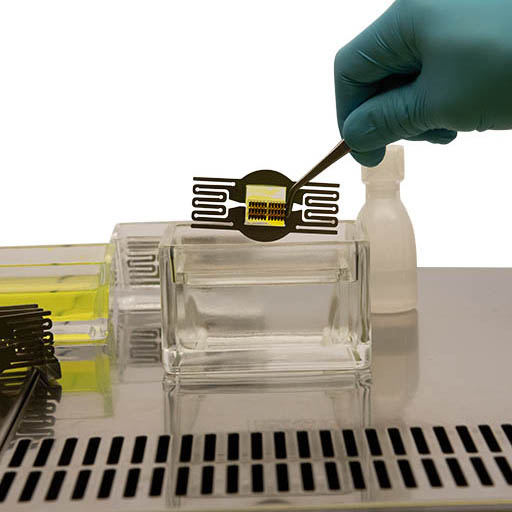Austrian firms UpNano and Cubicure have worked together to release a two-photon polymerization (2PP) material with a heat deflection temperature (HDT) of up to 300°C. Dubbed UpThermo, this high HDT material will hopefully open up nano 3D printing applications for electronics components.
3D Printing Electronics, Optics, and More
UpThermo is made using Cubicure’s hot lithography technology for viscous resin materials, about which Cubicure CEO Dr. Robert Gmeiner, states:
“Hot Lithography opens up a wider process window – also for light-polymerizing micro 3D printing. With our technology, polymers can be tailored to their application purpose and high-temperature-resistant components can also be produced. That was the basis of our collaboration with UpNano.”
TU Wien spinout UpNano offers systems that allow users 3D print tiny structures with details of 170 nanometers and up to centimeters in size. By combining ultra small features with relatively large parts, the company brings nanoscopic properties to a macroscopic world. UpNano already offers materials suitable for optics and bioprinting, but this novel chemistry for 2PP, opens up possibilities for electronics and electrical components, micro molds, optical parts and more.This collaboration will see both companies being able to leverage their technologies to the benefit of both their clients.
In this partnership, we’re also seeing a convergence of different engineering disciplines. For a long time, disparate fields of engineering and manufacturing were silos, relatively isolated from each other. Even on complex vehicles and other systems, electronics and mechanical engineering were strictly separated disciplines that would be integrated into assemblies and final parts later on. Only rarely did companies perform these activities in true conjunction.
3D Printing Enables Multidisciplinary Teams
With additive manufacturing (AM), we’re witnessing the emergence of integrated engineering and development teams that are collaborating on many fields and skills simultaneously. Because 3D printing can change parts to dissipate heat, cary fluids and channel electrical conduits while serving as a housing all at the same time such integration is advantageous.
Of course, we’re seeing more integrated engineering and other systems in other fields. Think of biomechanical engineers or others that make bio-inspired devices. Even deeper integration is possible, however. As evidenced in optics and biomechanical systems used in the body, bioprinted parts could be electrically driven or augmented by polymers quite easily. Think of new medicated stents, types of absorbable implants, and other novel devices in the body. Electro-optical breakthroughs could reinforce more devices in this area, as well.
2PP is a versatile technology that could make all of the requisite systems and parts using a single machine and a single technology, whether they be flexible soft robotics, 3D printed circuits, batteries or sensors. Direct write is another very flexible technology with similar potential.What we could be seeing is a truly revolutionary integrated design and manufacturing approach that blends electronics, biology, mechanics, and optics in integrated systems. Such developments in nanoprinting and beyond could lead to further breakthroughs at the edges of medicine, physics, engineering, material science, lithography, electronics and more.
UpNano is positioned at the intersection of these multiple domains. By being able to produce mechanical, electrical, and biological parts, the company may very well be one of only a few that is poised to usher in a true revolution in manufacturing.
